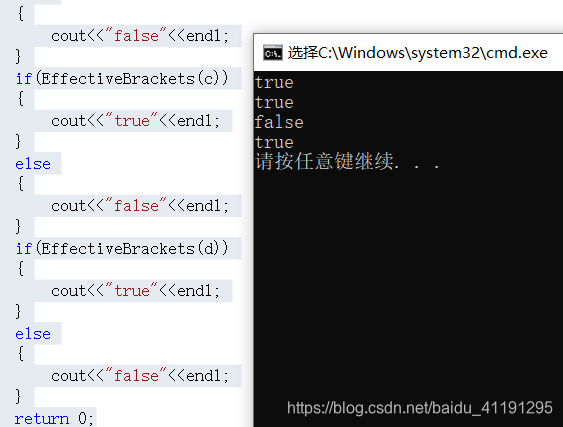题目描述
给定一个只包括 ‘(’,’)’,’{’,’}’,’[’,’]’ 的字符串,判断字符串是否有效。
有效字符串需满足:
左括号必须用相同类型的右括号闭合。
左括号必须以正确的顺序闭合。
注意空字符串可被认为是有效字符串。
示例:
输入: “()”
输出: true
输入: “()[]{}”
输出: true
输入: “([)]”
输出: false
输入: “{[]}”
输出: true
解题思路
首先,因为括号是成对出现的,所以,字符串的长度必须是2的倍数,如果不是直接return false。
其次,如果字符串为空,直接return true。
使用栈这种数据结构进行实现是比较方便的。
bool EffectiveBrackets(string s)
{
if(s.empty())
return true;
if(s.length()%2!=0)
return false;
stack<int> st;
for(int i=0;i<s.size();i++)
{
if(s[i]=='(')
st.push(')');
else if(s[i]=='{')
st.push('}');
else if(s[i]=='[')
st.push(']');
else if(st.empty()||st.top()!=s[i])
return false;
else
st.pop();
}
return true;
}
int main()
{
string a="()";
string b="()[]{}";
string c="([)]";
string d="{[]}";
if(EffectiveBrackets(a))
{
cout<<"true"<<endl;
}
else
{
cout<<"false"<<endl;
}
if(EffectiveBrackets(b))
{
cout<<"true"<<endl;
}
else
{
cout<<"false"<<endl;
}
if(EffectiveBrackets(c))
{
cout<<"true"<<endl;
}
else
{
cout<<"false"<<endl;
}
if(EffectiveBrackets(d))
{
cout<<"true"<<endl;
}
else
{
cout<<"false"<<endl;
}
return 0;
}
结果:

分析:
1.先判断字符串是否为空,若为空,则直接返回true。
2.判断字符串是否是2的倍数,如果不是,则返回false。
3.遍历字符串,如果字符为’(’,则在栈顶增加’)’,如果字符为’{’,则在栈顶增加’}’,如果字符为’[’,则在栈顶增加’]’。
4.如果栈顶为空,或者栈顶元素不是我们匹配的元素,则返回false。
5.遍历完成,出栈。
演示b过程
()[]{}
当i=0时,s[0]=’(’,入栈’)’
当i=1时,s[1]=’)’,st.top()=’)’,不为空且st.top()=s[1],出栈
当i=2时,s[2]=’[’,入栈’]’
当i=3时,s[3]=’]’,st.top()=’]’,不为空且st.top()=s[3],出栈
当i=4时,s[4]=’{’,入栈’}’
当i=5时,s[5]=’}’,st.top()=’}’,不为空且st.top()=s[5],出栈,结束。
演示c过程
([)]
当i=0时,s[0]=’(’,入栈’)’
当i=1时,s[1]=’[’,入栈’]’
当i=2时,s[2]=’)’,st.top()=’]’,不为空但st.top()!=s[2],return false

演示d过程
{[]}
当i=0时,s[0]=’{’,入栈’}’
当i=1时,s[1]=’[’,入栈’]’
当i=2时,s[2]=’]’,st.top()=’]’,不为空且st.top()=s[2],st.pop(),出栈。
当i=3时,s[3]=’}’,st.top()=’}’,不为空且st.top()=s[3],st.pop(),出栈,结束。
